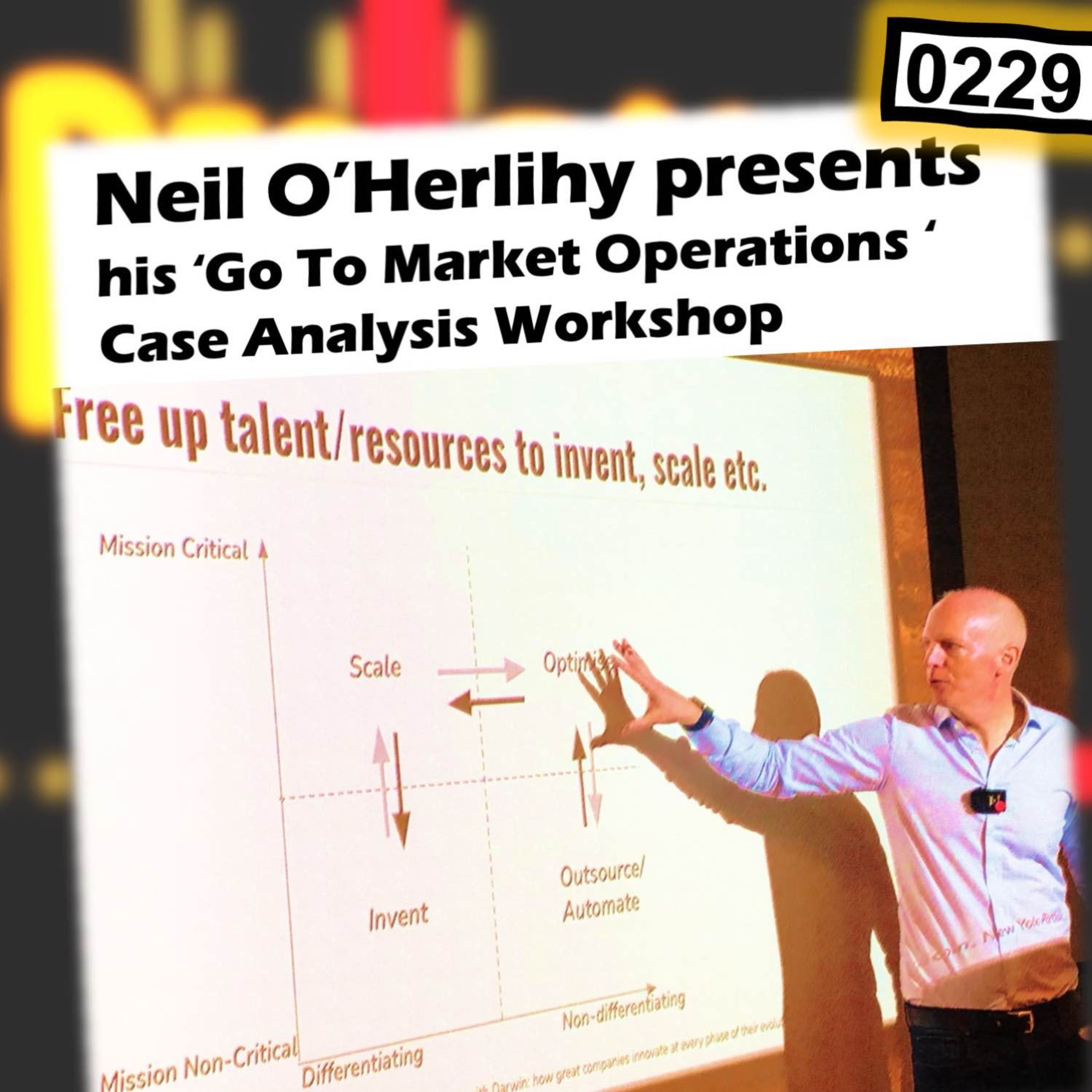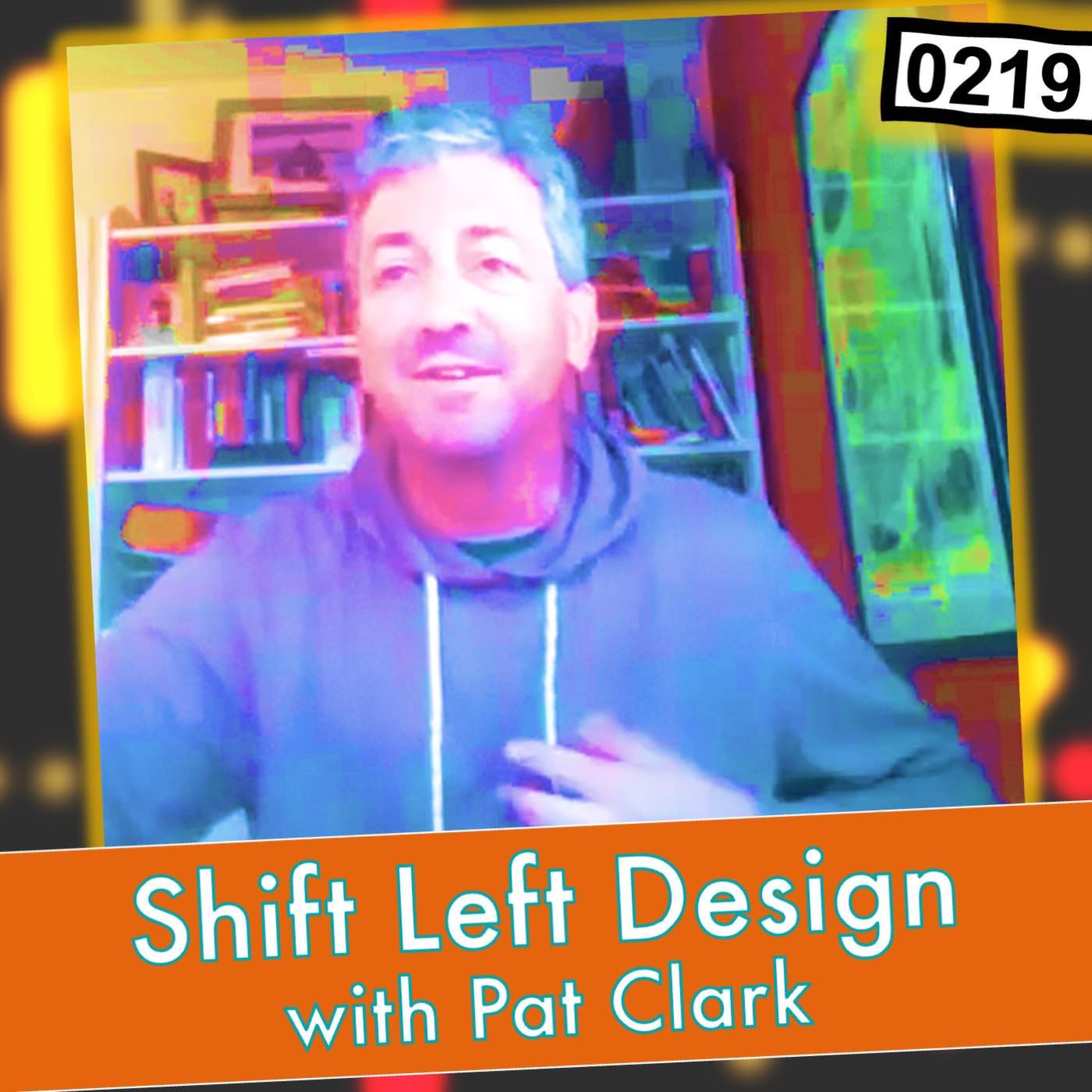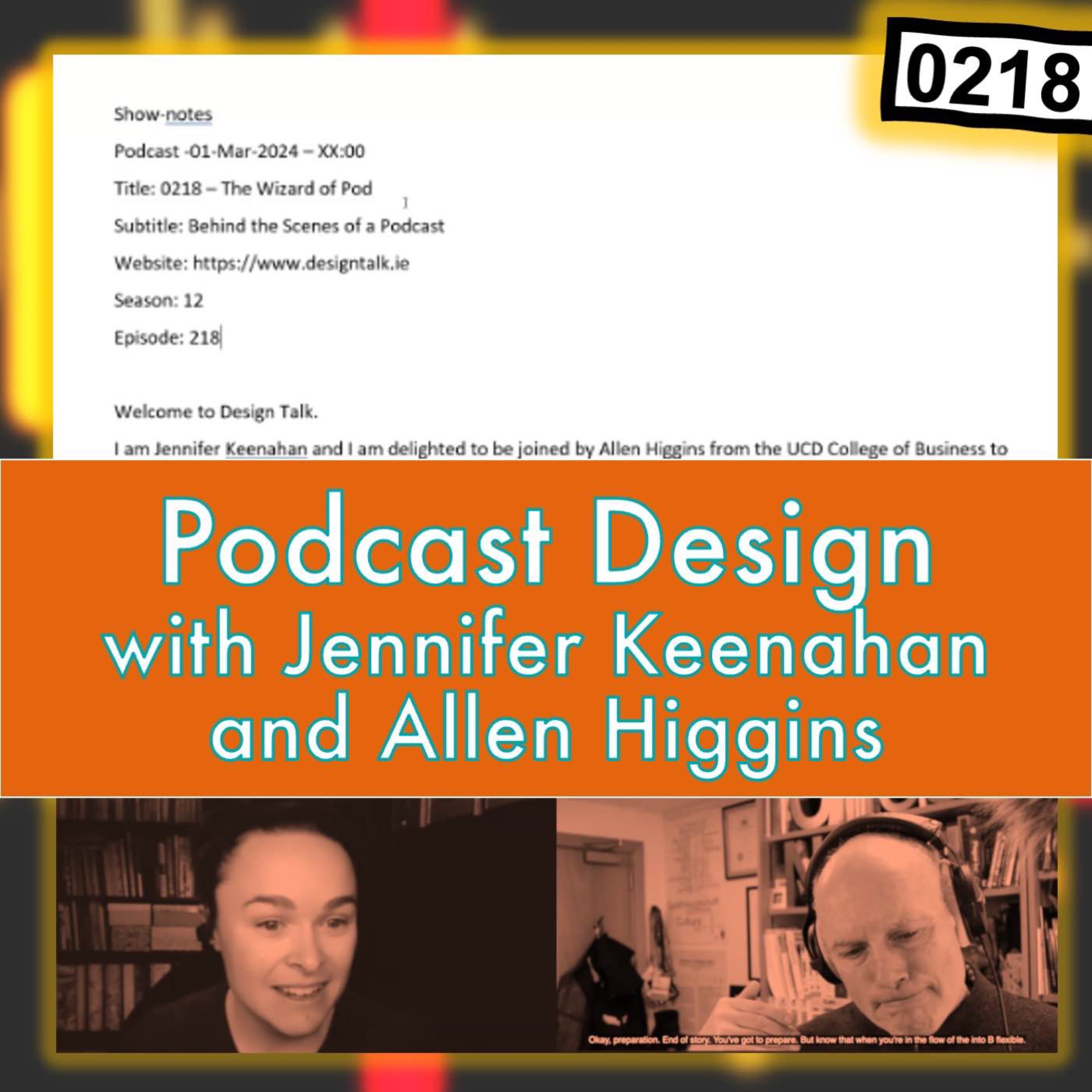Share

Design Talk (dot IE)
0229 - Go To Market Operations with Neil O'Herlihy
This is a recording of the "Go To Market Operations" case analysis workshop, from April 17th, held for the Pepperdine/UCD MBA-MSC class of 2024.
Neil O'Herlihy is introduced by Professor John Mooney. Neil talks about why your gut instinct is probably wrong in rapidly changing technology product environments because we are so used to thinking in terms of averages. People find it hard to develop an intuitive understanding of how power-law demand/reward curves work. “We don’t know what’s going to happen in the future, we just need to be ready when it does!”
Case Study Overview:
InceptionExp is a fictitious rapidly growing Silicon Valley company offering unique AI solutions that can improve and optimize themselves through AI. InceptionExp have low costs of sales and very high year-over-year (YoY) revenue growth with huge headroom. They are operating in a context of technology and scale race where there are strong economies of learning and scale. The rapid pace of technological innovation means the environment is highly uncertain. Demand for InceptionExp's product/service in EMEA is skyrocketing, requiring rapid expansion to address this market. InceptionExp's customers and markets exhibit power-law distribution, meaning a small percentage represent the bulk of the opportunity.
Given the rapid innovation in the AI-building-AI market we need to decide:
1. How should InceptionExp build its EMEA go-to-market team,
2. Should it use an EMEA go-to-market hub location
3. How it should prioritize resources in a power-law market, and
4. How much to focus on sales efficiency?
Notes:
Competing on the Edge: Strategy as Structured Chaos by Shona L. Brown, Kathleen M. Eisenhardt
The Lean Startup by Eric Reis
HBR on Strategy podcast (https://hbr.org/podcast/2023/07/defining-a-growth-strategy-in-uncertain-times)
episode recounting the different responses by Bill Gates and Steve Jobs on the future of the mobile phone.
Acknowledgements
Music
Title: “It was just cold”
Artist: Andrew Codeman
Source: https://bit.ly/2Msarcj
License: “CC BY 4.0”
Cover Art
Title: Eras ITC + photo of Neil presenting + 300% sat, 6,500K, pastels smooth.
Artist: Allen Higgins
Source: podcast-NeilOHerlihy.pptx
License: CC BY-NC-SA 4.0
Podcast License
Design Talk (dot IE) CC BY-NC-SA 4.0
The license can be viewed at https://creativecommons.org/licenses/by-nc-sa/4.0
By taking part you give permission for your voice to be recorded, for the recording to be edited, and for it to be posted and published as a podcast.
More episodes
View all episodes

231. 0231 - Consulting Values with Padraig Coffey and Angel Benito
01:12:27Welcome to Design Talk, I’m Kaushiki AgrawalI’m Christoph NeunsingerAnd I’m Akki Kumar and we are MSc Business Analytics students from UCD Smurfit Business School.Today we are ‘in conversation’ with Padraig Coffee (CEO) and Angel Benito (CTO) from Zartis, a software consulting firm situated in Cork, Ireland, talking about how to expand consultancy efforts and working with clients from different industries.1. How did you tackle the challenges of rapid expansion of Zartis from your founding through to now?2. Can you talk about your experiences expanding into new markets [countries or product markets?]3. The half-life of technology is incredibly short, how do you and your teams stay up-to-date?4. What do you consider when forming teams for client engagements? [When forming teams do you consider personal traits, knowledge maps?]5. When working with clients, do you have a general approach to problem-finding, a methodology or process to get the big picture?6. Let’s take a case, if client wants to do advanced analytics, but their systems are old or their data is a mess: how do you cope with deep strategic transformations [get client on board, manage expectations etc.]7. We’re interested understanding some of the problems of consulting. For example, how do you avoid the ‘halo’ problem? [e.g. fallen into the trap of ‘knowing best’ or reusing solutions from one site on another site without considering]8. Can you talk about your approach to Corporate Social Responsibility and outreach? [e.g. LevelUP]Questions from the audience.<conclude>That’s probably a good point to wrap it up.Thank you for taking the time to talk with us today.Notes, extra questions, and further reading:Zartis (https://www.zartis.com)Padraig was a guest on the pod back at episode 169 and cross-released by Zartis at…https://www.zartis.com/podcasts-story-of-software/design-talk/where-does-design-happen/AcknowledgementsMusic Title: “It was just cold”Artist: Andrew CodemanSource: https://bit.ly/2MsarcjLicense: “CC BY 4.0”Cover Art Title: Eras ITC + photo of panel + 25% shp, 60% brt, -14% cnt, 400% sat, 11,200K, greyscale, pastels smooth.Artist: Allen HigginsSource: podcast-Angel.pptxLicense: CC BY-NC-SA 4.0Podcast LicenseDesign Talk (dot IE) CC BY-NC-SA 4.0 The license can be viewed at https://creativecommons.org/licenses/by-nc-sa/4.0By taking part you give permission for your voice to be recorded, for the recording to be edited, and for it to be posted and published as a podcast.
230. 0230 - Technology Strategy with Morgan Hammersley
51:22In part 2 of the Pepperdine/UCD MBA-MSC workshop, John Mooney introduces Morgan Hammersley from Global Payments.Morgan talks about his approach to Technology Strategy and Business Alignment, taking us on his journey going from where the IT strategy is to just ‘get stuff done’ towards being more forward looking and ‘outcomes focused’ in terms of listening to and delivering what the business actually needs.Ask the business for feedback - would you recommend us to another customer? Then ask, are we delivering value? How are we doing from a service perspective? How do we engage and communicate with you?(The recording took place on April 17th, 2024.)Notes:NPS: Net Promoter Score Daily, weekly, monthly, quarterly, annual.JV: Joint VenturePI: Planning Interval (link)Purposeful Meetings: changing behaviours result in culture…Intent, vision, invested, alignment, outcomes.RAG colours: Red, Amber, Green.Use metrics to tell us if we’re moving in the right direction.Music Title: “It was just cold”Artist: Andrew CodemanSource: https://bit.ly/2MsarcjLicense: “CC BY 4.0”Cover Art Title: Eras ITC + photo of Morgan presenting + sharpness 44%, bright 28%, contr 30%, 206% sat, 5,388K, pastels smooth.Artist: Allen HigginsSource: podcast-Morgan.pptxLicense: CC BY-NC-SA 4.0Podcast LicenseDesign Talk (dot IE) CC BY-NC-SA 4.0 The license can be viewed at https://creativecommons.org/licenses/by-nc-sa/4.0By taking part you give permission for your voice to be recorded, for the recording to be edited, and for it to be posted and published as a podcast.
232. 0232 - NaviLens for accessible wayfinding with Emily Smith
26:46Our hosts are: Sophia, Owen and Tom. Today we are talking with Emily Smith, Assistive Technology Specialist in UCD.Emily, could you say a few words about role and how you came to champion accessibility?· I am always getting lost in buildings. How does anyone find spaces within places? [wayfinding systems, Google Maps, Navilens]· What is NaviLens? How do you use it? [an accessible wayfinding and information app that uses colourful QR codes to help individuals find their way around interior spaces] · Who is the primary target group, and, can anybody use it? · When did you first see a Navilens? [Kellogs pack]· Who makes Navilens? [Spanish company]· Are there any cases where Navilens is being rolled out? [New York MTA - subways and buses]· Can you track the use of a tag? [unique tags give data on number of times they have been scanned]· What do you need to consider when embedding Navilens in a space?· More questions from the audience? That’s probably a good point to wrap it up.Thank you for taking the time to talk with us today.Notes:https://www.navilens.com/en/https://www.ucd.ie/all/aboutus/campusaccessibility/navilens-accessibleinformationandcampusnavigation/https://lighthouseguild.org/how-the-simple-qr-code-became-an-empowering-navigation-tool/AcknowledgementsMusic Title: ImpulseArtist: Ben PruntySource: https://www.benpruntymusic.com/License: Non-transferable license. Permission granted by Ben Prunty (personal letter)Cover Art Title: Futura + The NaviLens Team Photo credit: NaviLens – www.navilens.com. Permission granted “Absolutely! You can use it! Happy to see the result! , don't hesitate to share it with us.”Artist: Allen HigginsSource: podcast-NaviLens.pptxLicense: CC BY-NC-SA 4.0Podcast LicenseDesign Talk (dot IE) CC BY-NC-SA 4.0 The license can be viewed at https://creativecommons.org/licenses/by-nc-sa/4.0By taking part you give permission for your voice to be recorded, for the recording to be edited, and for it to be posted and published as a podcast.
224. 0244 - Policy and European Economic Convergence Seminar
50:20In this seminar, Professors Frank Barry and Marcin Piątkowski contrast Ireland and Poland’s pathways to economic independence and growth, through the lens of industrial and economic policy. This, against the turbulence of world events straddling the 20th and 21st centuries. We look at the growth of these two European nations ex-post being constituent states of colonial empires.The seminar was chaired by Dorota Piaskowska, associate professor in strategy and international business at University College Dublin, Ireland.Frank Barry is Professor of International Business & Economic Development at Trinity Business School and a member of the Royal Irish Academy.And Marcin Piątkowski is Professor of Economics at Kozminski University, Warsaw, and Lead Economist at the World Bank.This talk was recorded in person with a live audience on April 8th, 2024, in the UCD Michael Smurfit Graduate Business School, Dublin, Ireland.The seminar was supported by the Embassy of the Republic of Poland in Dublin and the UCD College of Business.Location - Lecture Theatre N204 (followed by a reception in the Laurence Crowley Boardroom)UCD Michael Smurfit Graduate Business SchoolCarysfort Avenue, Blackrock, County Dublin Thank you for listening, please follow and share if you liked this episode.The musical elements used are from the ‘Adagio in G Minor’ released under a CC-BY 3.0 license.See the show-notes or the description for details.Notes and links:https://www.gov.pl/web/ireland/ambassadorhttps://people.ucd.ie/dorota.piaskowskahttps://marcinpiatkowski.comhttps://www.tcd.ie/research/profiles/?profile=barryfgAcknowledgementsMusic Title: Adagio in G minorArtist: Remo Giazotto attributed to Tomaso AlbinoniSource: https://soundcloud.com/dick-de-ridder/adagio-in-g-minor-albinoniLicensed by Dick de Ridder: CC-BY 3.0Cover Art Title: GraphicsAndTextArtist: Allen HigginsSource: Collage/various (CITO-podcast-FrankMarcin.pptx)License: CC BY-NC-SA 4.0Podcast LicenseDesign Talk (dot IE) CC BY-NC-SA 4.0 The license can be viewed at https://creativecommons.org/licenses/by-nc-sa/4.0By taking part you give permission for your voice to be recorded, for the recording to be edited, and for it to be posted and published as a podcast.
219. 0219 - Shift Left Design with Pat Clark
42:05Today I talk with Pat Clark, Senior Staff Engineer at ChargePoint, responsible for the Driver Portal and other web services. Pat is a unique blend of entrepreneur and software engineer with a passion for good design. This will be a provocative conversation about the state of the internet for people with disabilities and diverse needs.So, let’s start with this idea that Accessibility is the Zeroth usability requirement, that we’ve got to consider it in parallel with every other requirement, everywhere, all the time, all at once.Q: Why? Why bake accessibility into everything, why bring it into focus, and how do start the process?Q: What skills do you see as essential? Q: Can you talk about some examples?Q: You called it an ARIA label, so basically, nearly all access problem is an HTML problem.Q: what QA tools do you have in your toolbox. Q: What about installing overlays... Q: What if you break something? Q: You may be putting an awful lot of work into address a small and shrinking portion of the population.Q: Does accessibility affect you personally?Q: Let's finish on an observation that some of the foundational technologies developed for accessibility have gone on to improve everyone's experience of the web. Q: Is there anything else you’d like to add before we wrap-up?.Notes:https://www.chargepoint.com/en-gb/https://driver.chargepoint.com/ (driver portal)https://www.w3.org/WAI/people-use-web/tools-techniques/https://developer.mozilla.org/en-US/docs/Web/Accessibility/ARIA/Attributes/aria-labelAcknowledgementsMusic Title: The WorldArtist: Ben Prunty (2012)Source: https://www.benpruntymusic.com/License: Non-transferable license. Permission granted by Ben PruntyCover Art Title: Screenshot+HighContrast+GlowDiffusedArtist: Allen HigginsSource: podcast-PatAllen.pptxLicense: CC BY-NC-SA 4.0Podcast LicenseDesign Talk (dot IE) CC BY-NC-SA 4.0 The license can be viewed at https://creativecommons.org/licenses/by-nc-sa/4.0By taking part you give permission for your voice to be recorded, for the recording to be edited, and for it to be posted and published as a podcast.
218. 0218 - Podcast design with Jennifer Keenahan and Allen Higgins
24:14Welcome to Design Talk.I am Jennifer Keenahan and I am delighted to be joined by Allen Higgins from the UCD College of Business to talk about shaping and delivering a podcast.Today I have turned the tables on Allen. Usually, he’s behind the scenes directing the show. Today I want him to share what goes into planning and producing an episode.To start, Allen could you tell us a little about your background and how you came to bring podcasting into your teaching practice.Q: Let’s start with your teaching pod, Design Talk. You had this idea that you wanted to make a podcast, how did you start? Q: So, let’s say I have an idea that I want to make a podcast. How do I start? Q: What kinds of pods are there; how do you choose one? Q: Let’s talk a bit more about format. Q: How do you organise or structure your own pod? Q: What is the key to a strong interview? Q: So, sticking with interviews, how do you prepare?Q: Questions from the audience?Q: Is there anything you’d like add?Mentions, links and notes:Jennifer Keenahan (link)Mairéad O’Reilly – (link)Allen Higgins (link)Ruth Campion (link). Ruth is a game designer and 3D artistConor Reid (link). Conor hosts and produces his own award-winning arts and culture podcast, Words To That EffectSiobhán McHugh (link). Siobhán is an Irish-Australian author, podcast producer and critic, oral historian, audio documentary-maker and journalism academic.Audacity (link). Audacity is a freely available open-source DAW, a Digital Audio Workstation; a highly regarded and extremely capable software environment for audio engineering.AcknowledgementsMusic Title: Voltaic FluctuationsArtist: Ben PruntySource: https://www.benpruntymusic.com/License: Non-transferable license. Permission granted by Ben PruntyCover Art Title: Complex collageArtist: Allen HigginsSource: vignette_version.pptxLicense: CC BY-NC-SA 4.0Podcast LicenseDesign Talk (dot IE) CC BY-NC-SA 4.0 The license can be viewed at https://creativecommons.org/licenses/by-nc-sa/4.0By taking part you give permission for your voice to be recorded, for the recording to be edited, and for it to be posted and published as a podcast.
215. 0215 - Storytelling with Moin
01:03:21Hosted by Christina Phillips.We are proud to announce this seminar with Dr S M A Moin, a Senior Lecturer (Associate Professor) in Marketing at Queen Mary University of London, and Director of Teaching Associates at the School of Business. He is an interdisciplinary researcher and a published author in brand storytelling, strategy, leadership and creativity & innovation.Storified and creative teaching can break the clutter and connect with students’ rational brains by tapping into their emotions.Further reading, sources, mentions and acknowledgements.S. M. A. Moin. Creativity in the Imagination Age. Springer Books, (2022). S. M. A. Moin. Brand Storytelling in the Digital Age: Theories, practice and application. London: Palgrave Macmillan, (2020).Kay Peterson and David A. Kolb. How you learn is how you live: Using nine ways of learning to transform your life. Berrett-Koehler Publishers, (2017).HBP editors. Why your students are disengaged and and what you can do to draw them back in. Harvard Business Publishing, (2022)Joseph Campbell. The Hero with a Thousand Faces. Various publishers, (1949-2008)Alighieri Dante. The Divine Comedy. Various publishers, (-2017).Contact details:S M A Moin -- https://www.linkedin.com/in/smamoin/ Christina -- https://www.linkedin.com/in/christinajphillips/A video version of this episode is published on the Business Analytics Educators Forum’s YouTube channel at: AcknowledgementsMusic Title: Guitar HouseArtist: josh pan (2020)Source: https://www.youtube.com/watch?v=JL-LId8ZWBMLicense: License CC BY 3.0Cover Art Title: Complex collaboration for BAEFArtist: Nuno Machado and Allen HigginsSource: vignette_version.pptxLicense: CC BY-NC-SA 4.0Podcast LicenseDesign Talk (dot IE) CC BY-NC-SA 4.0 The license can be viewed at https://creativecommons.org/licenses/by-nc-sa/4.0By taking part you give permission for your voice to be recorded, for the recording to be edited, and for it to be posted and published as a podcast.
217. 0217 - Data Engineering with Julian Wiffen
43:04I am delighted to have Julian Wiffen to talk about some of the latest breakthroughs in generative AI and their application to data engineering.Julian is Director of Data Science for the Product team at Matillion.· To start, Julian could you share a little about your background in Data Science and introduce us to Matillion and its mission?· How does an independent services solutions company leverage while adding value to the models generated by the large LLM developers?· Can you share your some of the learning and discoveries you’ve made by researching and applying Gen AI to data engineering? · Can you share your thoughts on its impact on the way data science is done? [· What do you consider to be the entry-level skillset? · How do you approach teaching and learning skills in the area and what tips would you give a university educator?· On the topic of regulation and ethics for data scientists working with Gen AI. There is talk of mandating the 'human in the loop' approach for safety, that may even become regulation. How you see ‘human in the loop’ working?· Who are the key data science authors and media you refer to? [books, blogs, pods] · Is there anything you’d like add?Notes:Julian’s blogs at Matillion· Matillion: The Data Engineer’s Guide to Prompt Engineering part 1 (link)· Matillion: The Data Engineer’s Guide to Prompt Engineering part 2 (link)· Matillion: The Data Engineer’s Guide to Prompt Engineering part 3 (link)· Matillion: Evaluating the performance of different LLMs (link) Recommended to follow Andrew Ng, researcher-entrepreneur (homepage)AcknowledgementsMusic Title: The WorldArtist: Ben Prunty (2012)Source: https://www.benpruntymusic.com/License: Non-transferable license. Permission granted by Ben PruntyCover Art Title: Complex collaboration for BAEFArtist: Nuno Machado and Allen HigginsSource: vignette_version.pptxLicense: CC BY-NC-SA 4.0Podcast LicenseDesign Talk (dot IE) CC BY-NC-SA 4.0 The license can be viewed at https://creativecommons.org/licenses/by-nc-sa/4.0By taking part you give permission for your voice to be recorded, for the recording to be edited, and for it to be posted and published as a podcast.